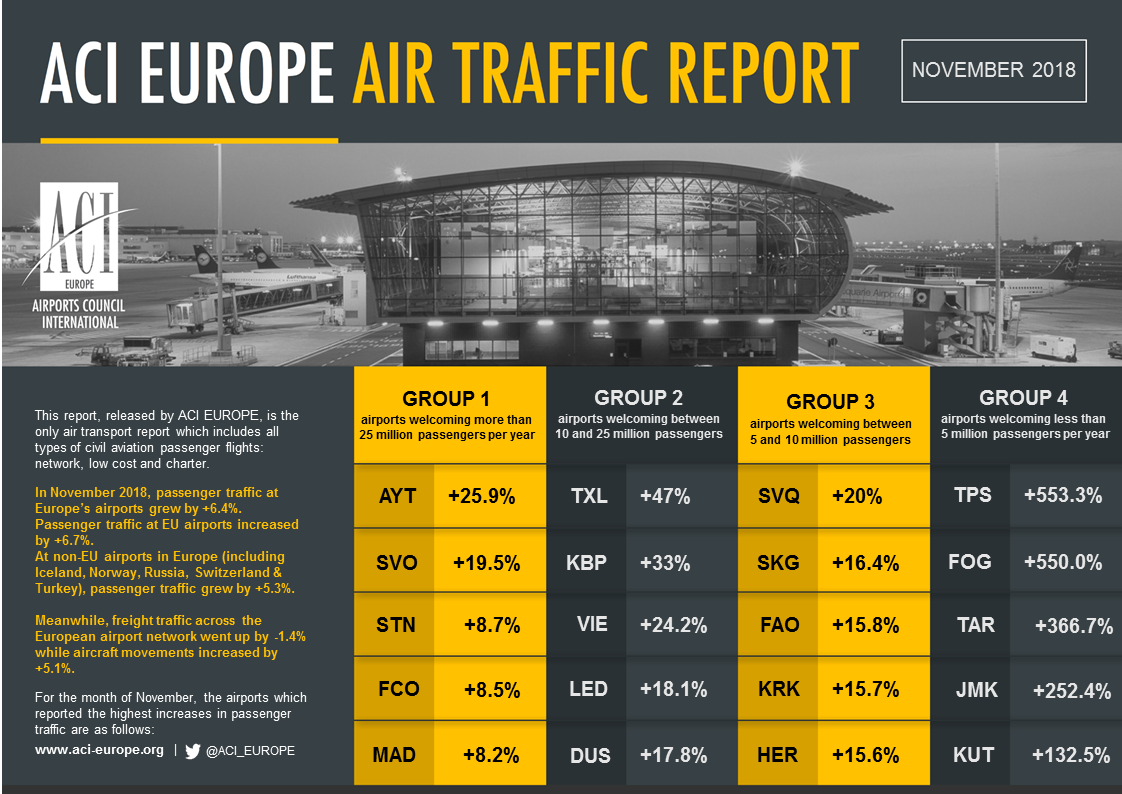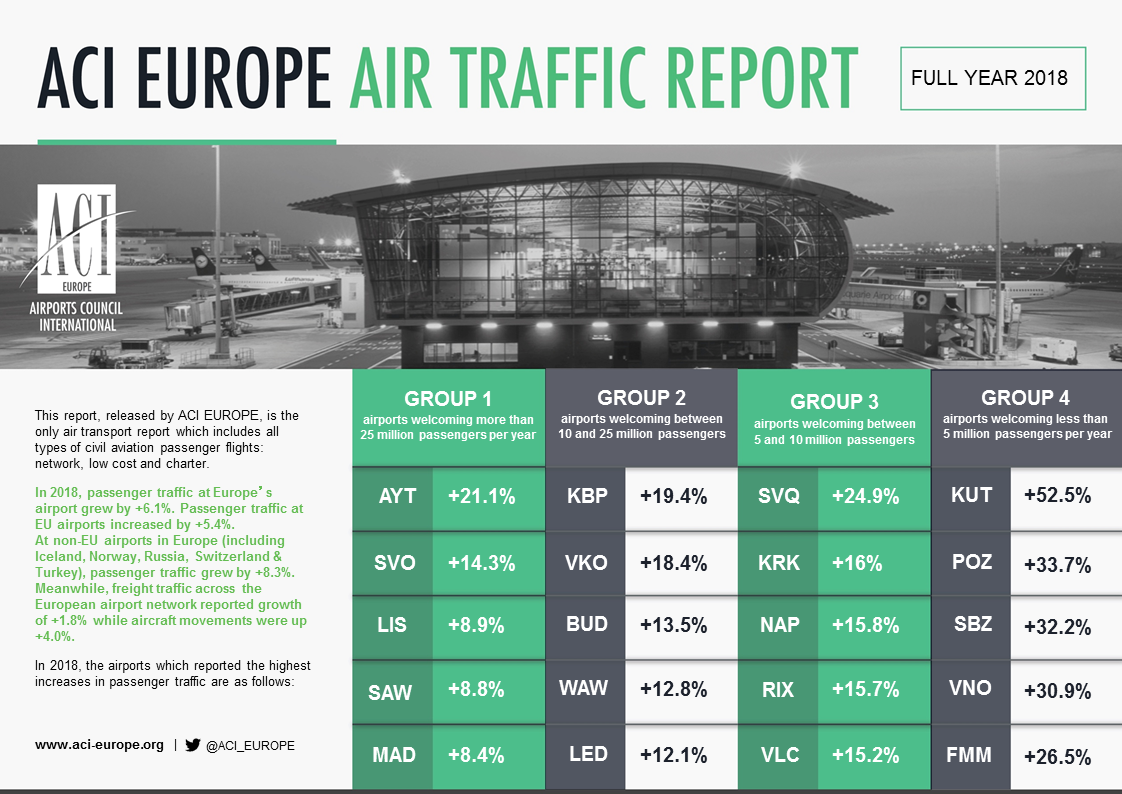Air passenger traffic up 6.1%0 in 2018, but slide in freight raises worries
6 February 2019- 136.6 million additional passengers at Europe’s airports in 2018
- Top 5 European airports welcomed an additional 16.5 million passengers
- Passenger traffic growth up 36% over the past 5 years
- Airport capacity constraints becoming more widespread & evident
- Freight traffic growth sharply decelerating at +1.8%
- Pressures on passenger traffic likely to come both from demand and supply sides in the year ahead
Brussels - European airport trade association, ACI EUROPE today releases its traffic report for December, Q4, H2 and Full Year 2018. This is the only air transport report that includes all types of airline passenger flights to, from and within Europe: full service, low cost, charter and others.
Passenger traffic across the European airport network grew by +6.1% last year, bringing the total number of passengers using Europe’s airports to a new record of 2.34 billion. While growth somehow moderated in 2018 when compared to the exceptional performance of 2017 (+8.5%), it remained very dynamic - especially considering underlying economic trends and geopolitical tensions. Continued airline capacity expansion played a major role, as aircraft movements grew by +4% - even faster than in 2017 (+3.8%).
Olivier Jankovec, Director General of ACI EUROPE commented “Once again, passenger traffic has shown remarkable resilience in 2018, with Europe’s airports welcoming an additional 136.6 million passengers. This means that in just 5 years, passenger traffic has expanded by more than a third (36%) – with more than 629 million additional passengers – of which 445 million were in the EU alone. Managing such growth has been quite a challenge and the strain on airport facilities and staff is real. Capacity and quality are now major issues for an increasing number of airports across Europe. This of course requires investment but also greater operational efficiency - through effective airport-ATM integration and alignment with all other stakeholders.”
Passenger traffic at EU airports posted an average increase of +5.4% in 2018 (compared with +7.7% in 2017) - with ATM disruptions, airline strikes & consolidation limiting gains in several markets up to the Summer. Since then growth has been on an upward trend, with December closing at nearly +7%.
Airports in the Eastern & Southern parts of the EU achieved the best performances, along with those in Austria and Luxembourg. Accordingly, the following capital & primary airports posted double-digit growth: Vilnius (+30.9%), Bratislava (+18.1%), Riga (+15.7%), Budapest (+13.5%), Tallinn (+13.4%), Malta (+13.2%), Warsaw-Chopin (+12.8%), Milan-Malpensa (+11.5%), Luxembourg (+12.2%), Athens (+11.2%), Vienna (+10.8%) and Helsinki (+10.4%). Conversely, the weakest results came from airports in Sweden (where passenger traffic stalled in the wake of the introduction of an aviation tax) and the UK (a reflection of mounting Brexit fears on the economy).
Meanwhile, non-EU airports saw passenger traffic expand by +8.3% (compared to +7.7% in 2017). However, unlike in the EU market, growth has followed a downward trend throughout the year, from an impressive +14.6% in January to +3.5% in December. This was mainly due to domestic demand at Turkish airports being affected by the country’s economic woes (total passenger traffic growth at Turkish airports stood at +0.9% in Q4), weaker demand at Norwegian airports and growth coming to halt at Icelandic airports towards the end of the year (-0.1% in December).
Conversely, airports in Russia, Belarus, Ukraine, Georgia, Israel, Albania, Northern Macedonia, Montenegro and Bosnia Herzegovina grew above the non-EU average. The best individual airport performances came from Kutaisi (+52.5%), Antalya (+21.1%), Tbilisi (+20.4%), Kiev (+19.4%), Kharkiv (+19.3%), Bodrum (+18.8%), Rostov (+18.8%), Moscow-Vnukovo (+18.4%), Skopje (+15.5%), Pristina (+14.7%) and Moscow-Sheremetevo (+14.3%).
The Majors (Europe’s Top 5 busiest airports) registered a +4.8% growth in passenger traffic in 2018, down from +5.5% the preceding year. This lower performance compared to the European average reflected mainly capacity limitations, intensifying hub competition & hub by-pass developments as well as airline strikes. Still, the Majors collectively welcomed 16.5 million additional passengers.
Frankfurt achieved the highest growth amongst the league (+7.8% - 4th position with 69.51 million passengers), on the back of a successful traffic diversification strategy. Istanbul-Atatürk posted the second best performance (+6.4% - 5th position with 68.19 million passengers) but saw passenger traffic slowing down significantly towards the end of the year (only +1% in Q4). The Turkish hub was followed by Paris-CDG (+4% - 2nd position with 72.22 million passengers), where strikes at the home-based network carrier took their toll. Meanwhile, capacity constraints more than halved growth at Amsterdam-Schiphol (+3.7% compared to +7.7% in 2017 – 3rd position with 71.05 million passengers) and also limited gains at London-Heathrow (+2.7%) - which remained the busiest airport in Europe, with 80.12 million passengers.
While performances also varied significantly between regional airports, many posted impressive passenger traffic gains in 2018 - a reflection of their agility and success in attracting airlines and developing air connectivity. These included Poznan (+33.7%), Sibiu (+32.2%), Memmingerberg (+26.5%), Seville (+24.9%), Kefallinia (+21.6%), Mikonos (+17.1%), Genoa (+16.7%), Krakow (+16%), Varna (+15.9%), Naples (+15.8%), Linz (+15.7%), Ostend (+15.7%), Valencia (+15.2%), Palermo (+14.8%), Toulon (+13%) and Nantes (+12.6%). However, smaller regional airports (below 5 million passengers per annum) underperformed the European average, growing by +5.1%.
FREIGHT DECELERATION
In contrast with passenger traffic dynamics, freight traffic decelerated sharply in 2018, with growth of only +1.8% - compared with +8.4% in 2017. The deceleration primarily affected EU airports (+1.1%) and less so non-EU ones (+5.6%). It turned into traffic losses in November (-1.4%) and December (-2.2%).
Among the top 10 European airports for freight, only the following reported growth: Liège (+21.6% - 8th position), Istanbul-Atatürk (+9.6% - 5th position), Cologne-Bonn (+2.7% - 9th position) and Brussels (+3.7% - 10th position).
Looking ahead Jankovec concluded “The trend of decreasing freight traffic is hard to ignore. It reflects weakening economic data and contraction
forces at play, not just in Europe but around the World. These will ultimately translate into lower passenger demand. Adding to that, volatile oil prices, labour cost pressures and more consolidation should also lead airlines to be more cautious with capacity expansion. So pressures on passenger traffic are likely to come both from the demand and supply sides in 2019.”
He added “With less than 60 days left before the UK exits the EU, BREXIT remains the top immediate risk. However, the latest no-deal contingency measures from the EU no longer provide for a capacity freeze on EU27-UK air routes for UK airlines. This will very much help mitigate the impact and protect air connectivity.”
TRAFFIC CATEGORIES & HIGHEST INCREASES 2018
During the full year of 2018, airports welcoming more than 25 million passengers per year (Group 1), airports welcoming between 10 and 25 million passengers (Group 2), airports welcoming between 5 and 10 million passengers (Group 3) and airports welcoming less than 5 million passengers per year (Group 4) reported an average adjustment of +5.5%, +6.7%, +6.5% and +6.7%.
The airports which reported the highest increases in passenger traffic during 2018 (compared with 2017) are as follows:
GROUP 1: Antalya (+21.1%), Moscow SVO (+14.3%), Lisbon (+8.9%), Istanbul SAW (+8.8%) and Madrid (+8.4%)
GROUP 2: Kiev (+19.4%), Moscow VKO (+18.4%), Budapest (+13.5%), Warsaw WAW (+12.8%) and St Petersburg (+12.1%)
GROUP 3: Seville (+24.9%), Krakow (+16%), Naples (+15.8%), Riga (+15.7%) and Valencia (+15.2%)
GROUP 4: Kutaisi (+52.5%), Poznan (+33.7%), Sibiu (+32.2%), Vilnius (+30.9%) and Memmingerberg (+26.5%)
During the month of December, airports welcoming more than 25 million passengers per year (Group 1), airports welcoming between 10 and 25 million passengers (Group 2), airports welcoming between 5 and 10 million passengers (Group 3) and airports welcoming less than 5 million passengers per year (Group 4) reported an average adjustment of +4.8%, +9.3%, +5.4% and +5.2%.
The airports which reported the highest increases in passenger traffic during December 2018 (compared with December 2017) are as follows:
GROUP 1: Palma De Mallorca (+20.7%), Moscow SVO (+17.6%), Antalya (+12.6%), London STN (+10.3%) and Barcelona El-Prat (+9.5%)
GROUP 2: Berlin TXL (+57.2%), Vienna (+25.8%),Dusseldorf (+24%), Kiev (+19%) and St Petersburg (+17.6%)
GROUP 3: Thessaloniki (+25.7%), Seville (+22%), Faro (+19%), Krakow (+16.5%) and Valencia (+15.5%)
GROUP 4: Kutaisi (+127%), Mikonos (+103.3%), Caen (+84.6%), Batumi (+66%) and Kefallinia (+53.6%)
The 'ACI EUROPE Airport Traffic Report – December, Q4, H2 & Full Year 2018’ includes 243 airports in total representing more than 88% of European air passenger traffic.



